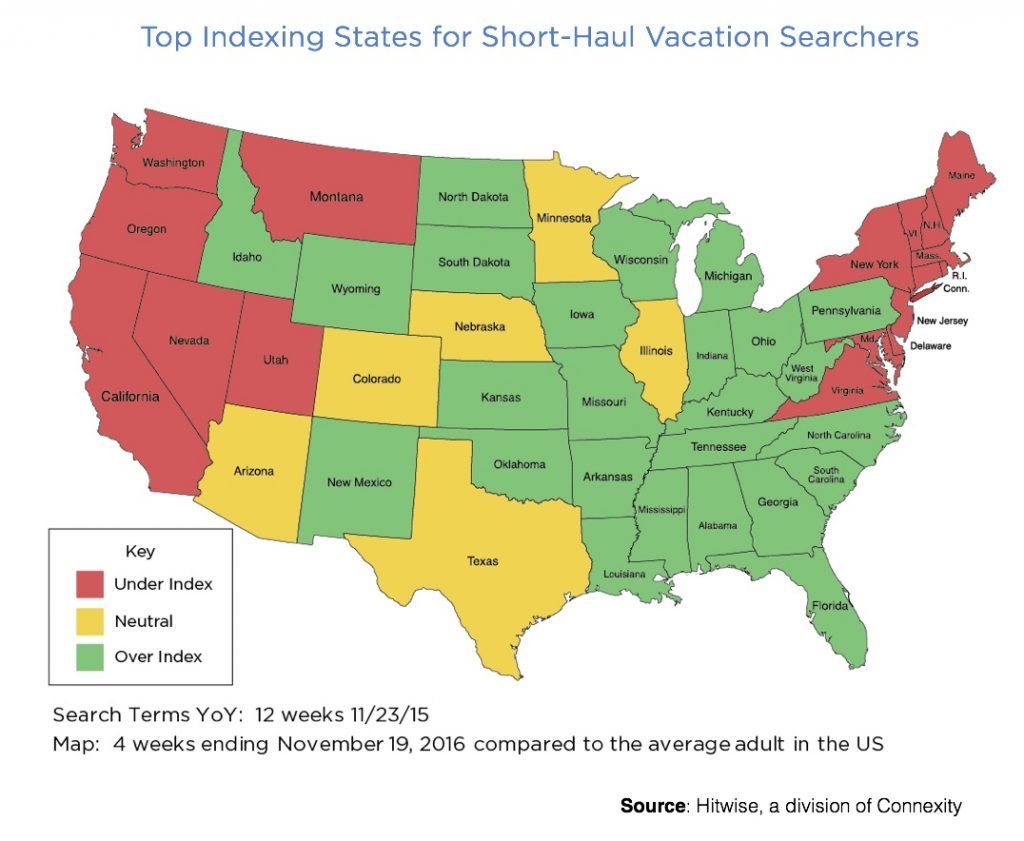Skift Take
In 2017, Americans' travel aspirations may reflect the country's political divide. We're still waiting to see how Trump's promises to tighten national borders will affect the trips people book this year.
The United States is still deeply conflicted over the recent presidential election, and could this lingering partisan divide affect Americans’ travel plans for 2017?
While other factors are undoubtedly in play, a recent study by Hitwise analyzed Americans’ 2017 travel searches and found that by and large, residents of traditionally Republican states in the Deep South and swing states in the Rust Belt were overwhelmingly planning short-haul domestic trips.
Meanwhile, residents of traditionally Democratic states in the Northeast and on the West Coast were less likely to plan domestic trips, with data suggesting they leaned toward long-haul, international trips.
“If the map looks familiar, it may be because it’s not far off from the red versus blue state split of the recent presidential election,” says Rochelle Bailis, director of content at Connexity, which owns Hitwise. “The states won by Republican Donald Trump somewhat mirror the states that over-index for short-haul searches — suggesting these consumers prefer to stay in their own state or the continental U.S.
“Conversely, consumers from coastal blue states, generally characterized by dense urban centers, are less likely to conduct short-haul travel searches.”
300 Percent Increase In Staycation-Oriented Searches
Hitwise found a 63 percent drop year-over-year in searches for the term “staycation,” but a nearly 300 percent increase in searches for variations on the term. “This suggests that consumers are now familiar with the term ‘staycation,’ but are getting more creative with their research,” Rochelle Bailis says.
It should be noted that many Clinton voters live in states won by Trump, and vice versa, so the short-haul trend isn’t synonymous with Trump voters and international vacations aren’t code words for Clinton supporters.
The Hitwise report found that short-haul travelers spend an average of $1,105 per trip, and 21 percent spend less than $300 per trip. Long-haul travelers spend an average of $3,253 per trip, with 19 percent spending more than $3,000. More than half of short-haul trips involve a car and more than 25 percent involve domestic flights. While nearly 40 percent of long-haul travelers will fly, 21 percent will use a car followed by ships (12 percent), buses (10 percent), and rail (5.7 percent).
These trends among red and blue states could be highly influenced by differences in household income. According to the U.S. Census Bureau, heartland states like Arkansas often have a lower median household income than coastal states like New York.
However, one can also speculate whether these trends in trip types might have been propelled by a shift in post-election American attitudes and values.
Some ardent Clinton supporters may actually be following through on their well-documented threats to leave the country (or at least spend more time outside of it). Conversely, Republicans and other conservatives may try to assert their claim to America by staying close to home, rather than looking abroad for respite.
Canada — the traditional destination for frustrated Democrats who muse about expatriating — came in number two in the top 10 international destinations being searched, according to Hitwise. Mexico was ranked number one.
The Daily Newsletter
Our daily coverage of the global travel industry. Written by editors and analysts from across Skift’s brands.
Have a confidential tip for Skift? Get in touch
Tags: politics, trip planning, trump, u.s., u.s. travel
Photo credit: Many Americans residing in the nation's heartland are planning domestic road trips for 2017, rather than international vacations. Pictured is a car with Mount Rushmore in the background. 88186 / 88186
